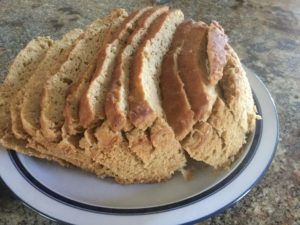Sourdough is an ancient method of bread making using only flour and water which ferments over a few days creating a natural, wild yeast starter to be used in baking. A portion of the starter is used for baking and the rest is saved and fed for future use.
Prior to the mid-nineteenth century, all leavened bread was prepared with a starter culture. Because of the time-intensive process and unpredictability of homemade sourdough, packaged yeast was created to shorten the preparation time.
Sourdough contains a higher amount of Lactobacillus bacteria which creates more lactic acid and less phytic acid. Phytic acid, found in grains, inhibits enzymes needed for the breakdown of proteins and starch in the stomach resulting in the well-documented digestive issues associated with grains. Additionally, phytic acid binds with minerals such as calcium, magnesium, iron and zinc, making these critical nutrients unavailable to the body.
The wild yeast created through cultured,sourdough bread pre-digests and neutralizes the phytic acid, thereby releasing the micronutrients for absorption and making the bread easy to digest. Some of the nutrients found in sourdough include vitamins B1-B6, B12, folate, thiamin, niacin, riboflavin, vitamin E, selenium, iron, manganese, calcium, magnesium, phosphorus, zinc and potassium, along with a balance of proteins and fatty acids.
Although the friendly bacteria (Lactobacillus) are destroyed in baking, they create metabiotics—short-chain fatty acids (SCFA’s) and bacteriocin—in the process. This creates an acidic environment that favors probiotics, promotes a healthy gut population, regulates yeast overgrowth and negates inflammatory responses throughout the body. Breads made with packaged yeasts, on the other hand, do not have the benefit of the metabiotics.
Some additional benefits of sourdough bread:
The fermentation process depletes damaged starches within it, resulting in a lower glycemic index with less of an insulin spike of other breads. (Moderation is key here.)
With gluten-containing grains, the longer prep time breaks down the gluten into amino acids, making digestion easier, even for some with gluten sensitivity.
Acetic acid, produced during the sourdough fermentation process, inhibits the growth of mold creating a natural preservative of the bread.
When purchasing sourdough, look for the words “culture” or “starter” on the label to ensure the sour dough flavor has been produced by fermentation.
References:
Huffnagle, Gary B., The Probiotics Revolution
http://cookusinterruptus.com/blog/?p=4245. Top 10 Reasons to Eat Sourdough Bread
http://www.sourdough.co.uk. So why is Sourdough bread healthier than ordinary bread?
http://www.fermentedhealth.com. We’ve heard about probiotics and prebiotics but what are metabioatics?
No Comments Yet